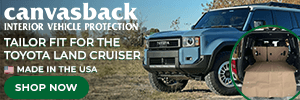The Rock Sliders look a lot like the stock Toyota Sliders. How are they different? Do they provide more protection and better footing?
Navigation
Install the app
How to install the app on iOS
Follow along with the video below to see how to install our site as a web app on your home screen.
Note: This feature may not be available in some browsers.
More options
You are using an out of date browser. It may not display this or other websites correctly.
You should upgrade or use an alternative browser.
You should upgrade or use an alternative browser.
🛠️ Member Build 24' WCP Cool Whip
- Thread starter advnt4re
- Start date
Member Build
- Thread starter
- #22
The Rock Sliders look a lot like the stock Toyota Sliders. How are they different? Do they provide more protection and better footing?
Generally with aftermarket frame/rock rails you're paying for something that is much more robust and stout. You can see the difference in design when you look at their supports and the way they're mounted to the frame. The oem ones might be fine for some light work but I wouldn't really want to put those thin support & mounting brackets through any real hard impacts. The CATunedOffroad will also stick out more, giving you a larger width of protection and can be better used as a step. Aftermarket sliders also give you more design flexibility for those who want a straight/angled slider or ones with a kickout. In summary, yeah much more/better protection, hope that helps!
Thank you. That’s what it looked like to me from the pictures. I like them because appearance wise they are not a big departure from the OEM Sliders. I have a 2024 GX. Will these sliders bolt right on? I like the looks of your build
- Thread starter
- #24
Fitment-wise I believe they should bolt right-on to the gx550 with the same trimming of the lower plastic trim, given they have the same chassis and frame mounting points. The lower plastic trim of the gx550 looks to be identical to the 250 series LC from a quick google search I did, but I would just double check that.Thank you. That’s what it looked like to me from the pictures. I like them because appearance wise they are not a big departure from the OEM Sliders. I have a 2024 GX. Will these sliders bolt right on? I like the looks of your build
Thanks for the photos @advnt4re ! How did you fasten the breather to the fuse box? I'm guessing you didn't drill into it, did you use some 3m double sided tape?@LCOceans @PixelMagic
Installation of a rear differential breather kit on the 250 series is a breeze. A rear differential breather kit is crucial for an off-road truck because it helps prevent water and debris from entering the differential, which can cause damage and premature wear and shorter service life. This is more important if you find yourself doing water crossing quite often.
You will need some basic tools and some zip-ties. You can buy either the ARB Diff Breather Kit or Amazon Diff Breather Kit on amazon. Both kits are almost identical and interchangeable. The hose that ARB and other companies both supply are a harder plastic hose. For those who live in cold climates, you can opt to replace the hose with higher durability fuel line of the same size. This should hold up better and have more longevity.
View attachment 31528
Pull off your oem breather vent with a wrench and attach the new vent & hose. The differential breather hose attaches to the rear axle. It's important to leave some additional length (in my case I left a coil or 2) before securing the hose to the vehicle to account for suspension travel / full drooping of the rear axle.
View attachment 31529View attachment 31530View attachment 31531View attachment 31532
Next is to determine where you want the breather and filter mounted. Popular places are high up in the engine bay or high up in the rear interior cabin, with the later being much more work and routing. I chose to mount the filter & end high up in my engine bay on the passenger-side. When routing, make sure the hose is clear of any moving suspension components to avoid damaging the hose when the suspension cycles. I routed my hose on the right-side along the frame, zip-tying it along the way to existing hoses and/or harnesses to full secure the hose and get rid of any slack.
View attachment 31533
Routed and secured the other end to behind my fuse-box, in-between that and the hybrid system. I may consider relocating that in the future as it takes up some space for wiring around my Garmin Powerswitch but that's a job for another day. Excuse the dirty truck, it's been raining a lot here. The whole thing can be done in an hour or two, hardest part is the planning & routing of the hose!
- Thread starter
- #26
Correct, I didn't want to drill into the side of the fuse-box for obvious reasons, a good cleaning of the surfaces and 3M automotive double sided tape and it's held up great so far. You will have a lot of freedom with where you can mount your breather extension and filter.Thanks for the photos @advnt4re ! How did you fasten the breather to the fuse box? I'm guessing you didn't drill into it, did you use some 3m double sided tape?
- Thread starter
- #27
Still need to get around to completing some write-ups but here's some quick shots I took earlier this week.


- Thread starter
- #28
Victory 4x4 rear lower shock skids & Dr.KDSS bolt-on trackbar/panhard bar correction kit on. Both super easy to DIY and install at home. The skids will protect my rear lower shock mounts from nasty pitting during any high-speed desert runs and getting damaged/scraped during any crawling, both of which I've dealt with on my previous 4R. Not necessary if your rig lives on pavement 90% of the time, but I'd definitely recommend if it doesn't. The trackbar correction kit's purpose is to bring back the trackbar angle and suspension cycling to within OE spec as well as re-center my rear axle after my lift.
- Thread starter
- #29
Installed a Garmin PowerSwitch for my electronics controller. Not having to figure out a place for a switch panel / physical buttons on already limited real estate was the one of the pros. App carplay integration or controlled from your phone. Easy installation, I’d recommend a negative bus bar for a tidy installation. I'd recommend pairing it with a negative busbar to make wiring everything a little bit cleaner.
Other Pros: Bluetooth wireless connection so I can be away from my truck’s cabin at camp and still be able to control the switches. Not as pricey as the switchpro + terminal block or spod setups I’ve run in the past. Garmin quality + warranty. Dimmable & On/off toggle, momentary switch, & strobe functionality all of which is customizable in terms of on/off strobe intervals. 6 30 amp max outputs, and that’s expandable with more units, customizable channel groups + other features you’d expect from high end switch panel controllers. Oh and low voltage battery shutoff protection.
Cons: sometimes I want physical buttons instead of having to swap to the app on CarPlay
If I had to nitpick, even though the app does allow for button / strobe customization, I found that SPOD’s app allows for more control (in terms of strobe on/off times).
Mounted by drilling small holes through the fusebox cover & weatherseal. The main power wire for the powerswitch is connected to the vehicle's jump point (drilled a hole through the cover as well & weatherseal), similar to what Brock's video outlines. The busbar main negative is connected to a factory ground point behind the top-left EV components.
Last edited:


